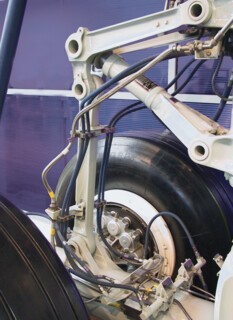Awheel unit from one of the older, smaller Airbus brothers of the A380 which has just been unveiled in Toulouse is on display in the foyer of the Science Museum. It is very large and very good to look at. Some of the struts have a bone-like elegance. The layout of hydraulic hoses is shipshape. The quality of the metalwork and the paintwork is very fine. But you don’t just admire the look of the thing; you start asking questions. Why (as the warning label insists) must the massive tyres be filled with nitrogen? Is that disc on the inside of the wheel a brake? And so on. You look, and then find reasons to look longer. The cavernous gallery which deals with the history of aircraft and their engines is high above this exhibit, right at the top of the museum. You ask questions there too.
Curiosity about bits of aeroplanes, like an interest in the form taken by a leaf, an insect’s leg or a dinosaur bone, can be aesthetic as well as practical or scientific. The art involved is as likely to be storytelling as sculpture: the configurations of both creatures and engines imply plots. Playing Poirot, questioning the suspect object and doing a little background reading, lets you see the ways their environment shaped them, and how it is possible to deduce from shape and position the way parts work together.
I have been to this part of the museum more than once to look at a particular engine: the Rolls-Royce Merlin, famous for having powered most Spitfires during the Second World War. I don’t know what every part does, but there is pleasure in trying to parse a sentence in a foreign language. The Merlin is now downstairs, labelled as ‘the engine which saved Britain’, close by Miss England, a contender for the water speed record, in a display called ‘Making the Modern World’. Upstairs in the tiered steel rack that holds material evidence of the ‘power’ part of the history of powered flight, I found the engine it evolved from, the Rolls-Royce ‘R’. Suspended above you in the same gallery is the float plane it was fitted in, the Supermarine S6B, and in a case nearby the Schneider Trophy that the S6B won outright in 1931.
This competition was itself a force in aircraft evolution. Announced in 1911 by Jacques Schneider, the French undersecretary for air, it was an international contest intended to stimulate progress in civil aviation. It soon became a much narrower competition between planes designed for speed alone. The 1922 race was won at 145 mph, the 1931 race at 340 mph. The same aeroplane set a world speed record of 407 mph a couple of weeks later. The feedback was primarily into military, not civil aeronautics – most significantly, from Britain’s point of view, into the Spitfire. Developments in the engines in the museum – in the weight and precision of machined castings; in the complexity of the pipework and moving parts; in the way, in the case of the Rolls-Royce engine, that a V formation of 12 cylinders replaces the radial arrangement of earlier engines around it – read as analogous to simple Darwinian evolution. Fitter designs replace those which are less fit. When you look for the reasons underlying mutations that have changed the look of engines, you find a narrative of unexpected problems met and unexpected failures remedied, as well as the more obvious, unending quest for greater speed and reliability. Progress, though driven by economics and military ambition, was also an expression of pure delight in making a more perfect machine.
The most brutal test of the Merlin engine’s fitness came when it was used in combat. In early models, negative G caused the fuel feed, which was via a carburettor, briefly to fail. German aircraft, powered by engines with fuel injection, could escape a pursuing Spitfire by going into a steep dive. At first, Spitfire pilots kept the fuel flowing by doing a half roll before diving after their quarry. An interim engineering solution to the problem was found by Tilly Shilling, of the Royal Aircraft Establishment at Farnborough (she was a remarkable woman, a racing motorcyclist as well as a professional engineer). ‘Miss Shilling’s Orifice’ was a metal disc with a small hole in the middle, fitted into the fighter’s fuel pipe. When the pilot accelerated in a dive the disc stopped starvation of the engine (I’m hazy ab0ut precisely how). By March 1941 Miss Shilling’s Orifice had been fitted as standard throughout Fighter Command.
During the course of the war the horsepower of the engine was doubled to 2000 hp. It was the kind of building on experience that has added refinement upon refinement to more modern internal combustion engines. A display case in the materials gallery devoted to the latest Jaguar diesel engine explains, for example, that carbon fibres in the steel of the cylinder block allow it to be stronger, lighter and more compact.
Yet petrol engine anatomy, like the anatomy of vertebrate quadrupeds, is, to the untutored viewer, one of conserved, recognisable elements. The same amateur eye finds the general configuration of passenger aircraft highly repetitive. The newly displayed A380 is bigger than its rivals, but ignore size and they all look very similar, even more so than, say, half a dozen different sea birds on a single cliff. Its future will be determined, as the Merlin engine’s was, in battle. It may win the commercial war with Boeing – it doesn’t combine technological overreach with commercial finger-crossing as Concorde did. On the other hand, it just may, like Brunel’s Great Eastern, be too far ahead of the game. We, the passengers, may fail to be charmed. The mockups of cocktail bars and first-class cabins look blandly four-star. The rows of cabin-class seats look like a totalitarian nightmare.
Either way it will find its place at the Science Museum, where both the wonderful aero engine which saved Britain and (for example) the wonderful calculating engine that Charles Babbage designed but never managed to see built are both duly honoured.
Send Letters To:
The Editor
London Review of Books,
28 Little Russell Street
London, WC1A 2HN
letters@lrb.co.uk
Please include name, address, and a telephone number.


